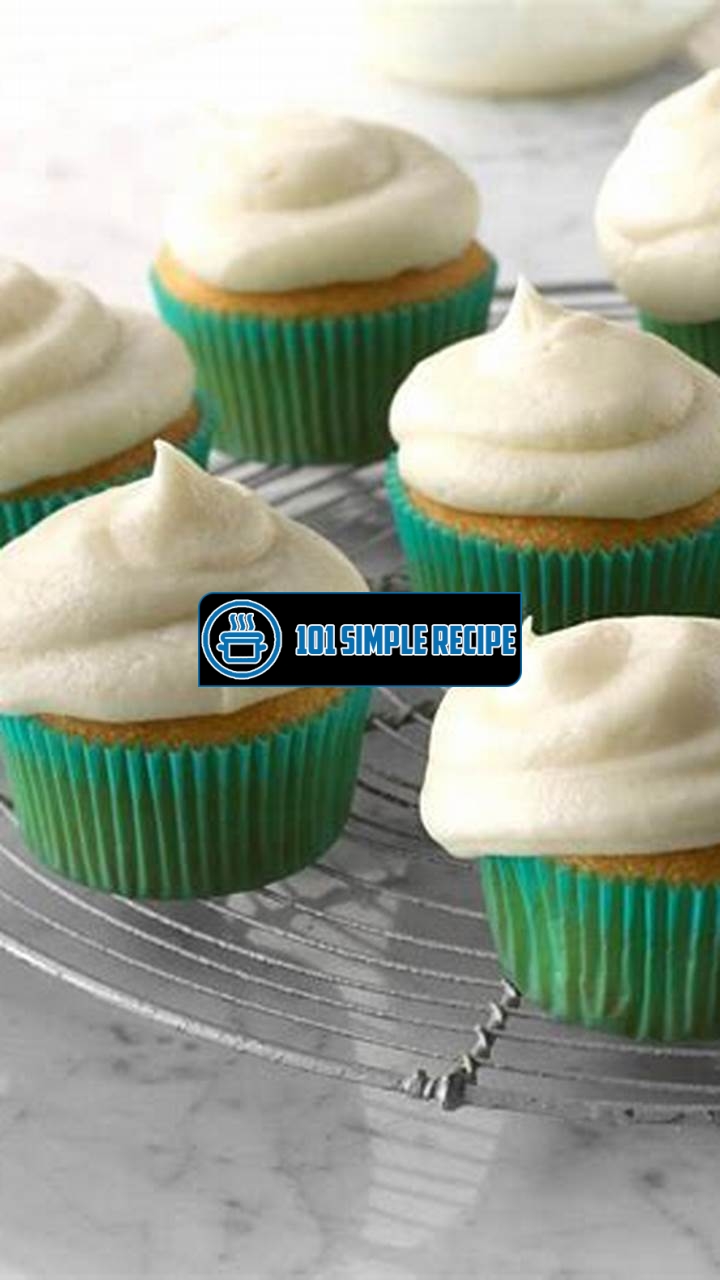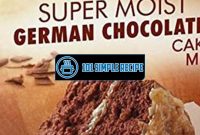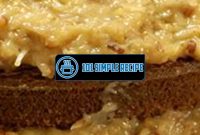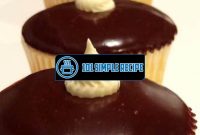Are you searching for the perfect vanilla buttercream frosting recipe? Look no further, because we have the easiest one ever! This recipe is simple, delicious, and only requires a few basic ingredients. Whether you are a baking pro or just starting out, this frosting will be your go-to for all your sweet treats. The best part? It takes just minutes to make! So, grab your mixing bowl and get ready to whip up a batch of this creamy, dreamy vanilla buttercream frosting. ✨

The Science of Buttercream Frosting
Buttercream frosting is a classic dessert staple that adds a delightful sweetness and creamy texture to cakes, cupcakes, and other baked goods. Its popularity lies in its simplicity and versatility, as it can be easily flavored and colored to suit any occasion. To truly master the art of making buttercream frosting, it’s important to understand the science behind its key ingredients and how they work together to create a delectable treat.
The Magic of Butter
Butter, the star of any buttercream frosting, plays a crucial role in its flavor and texture. Its high fat content gives the frosting a rich and creamy consistency that melts in your mouth. The fat in butter coats the sugar particles, preventing them from dissolving too quickly and creating a gritty texture. Instead, it creates a smooth and velvety finish that is irresistible.
Additionally, the fat in butter adds stability to the frosting, allowing it to hold its shape and maintain a fluffy texture. This is especially important when piping decorative designs onto cakes or cupcakes.
When choosing butter for your frosting, it’s important to opt for unsalted butter. Salted butter can alter the flavor and make the frosting overly salty. Using unsalted butter also allows you to control the amount of salt in the recipe, ensuring that the sweetness of the frosting shines through.
The Sweetness of Sugar
Sugar is another essential ingredient in buttercream frosting. It not only adds sweetness but also contributes to the texture and stability of the frosting. The sugar crystals mix with the fat in the butter, creating a smooth and creamy consistency.
Confectioners’ sugar, also known as powdered sugar, is the preferred choice for buttercream frosting. This fine sugar dissolves easily and prevents any graininess in the final product. It’s important to sift the sugar before adding it to the other ingredients to remove any lumps and ensure a silky smooth frosting.
When making buttercream frosting, it’s crucial to strike the right balance between sweetness and flavor. Too much sugar can overpower the other ingredients and make the frosting cloyingly sweet. On the other hand, too little sugar can result in a runny frosting that lacks body. Achieving the perfect sweetness requires careful measurement and experimentation.
The Perfect Vanilla Flavor
Vanilla is a classic flavor that complements the buttery and sweet components of buttercream frosting. It adds a subtle warmth and depth of flavor that enhances the overall taste of the dessert.
While both vanilla extract and vanilla bean paste can be used to flavor buttercream frosting, the choice ultimately depends on personal preference. Vanilla extract is made by soaking vanilla beans in alcohol, while vanilla bean paste contains ground vanilla beans suspended in a thick syrup. Both options infuse the frosting with a delightful vanilla aroma and taste.
To incorporate vanilla into your buttercream frosting, add a tablespoon of vanilla extract or a teaspoon of vanilla bean paste to the mixture. Start with a smaller amount and taste as you go, adjusting to your desired level of flavor intensity.
Now armed with the knowledge of the science behind buttercream frosting, you can create your own delectable masterpieces. Experiment with different flavors and techniques to discover the perfect combination for your next baking adventure. Whether you’re frosting a birthday cake or piping delicate flowers onto cupcakes, the science of buttercream frosting will guide you towards creating desserts that are both visually stunning and utterly delicious.
Choosing the Right Tools and Ingredients
When it comes to making the easiest vanilla buttercream frosting, having the right tools and ingredients is essential. By using quality ingredients and the proper equipment, you can ensure that your frosting turns out perfectly every time. Here are the key elements you’ll need:
Quality Butter is Key
The first and most important ingredient for any buttercream frosting is, of course, butter. To achieve the best results, it’s crucial to use high-quality butter. Look for butter that is unsalted and made from 100% pure cream. This will give your frosting a rich and creamy flavor.
Note: Using high-quality butter will make a significant difference in the taste and texture of your vanilla buttercream frosting. It’s worth investing in a good brand.
Avoid Imitation Vanilla
Another essential ingredient in your vanilla buttercream frosting is vanilla extract. While it may be tempting to reach for the artificial imitation vanilla, it’s best to use pure vanilla extract for the best flavor. The real deal will give your frosting a natural and authentic taste.
Note: Pure vanilla extract is made from real vanilla beans and has a more intense and complex flavor compared to imitation vanilla.
Don’t Forget the Powdered Sugar
In addition to butter and vanilla extract, powdered sugar is a crucial component of vanilla buttercream frosting. The powdered sugar not only adds sweetness but also helps to thicken and stabilize the frosting. Be sure to sift the powdered sugar before adding it to avoid any lumps in your frosting.
Note: Sifting the powdered sugar will ensure a smooth texture in your frosting and prevent any unwanted grittiness.
By having these key ingredients on hand and using the proper tools, you’ll be well-equipped to make the easiest vanilla buttercream frosting ever. Remember to use quality butter, opt for pure vanilla extract, and don’t forget to sift the powdered sugar. With these tips in mind, you’ll be able to create a delicious and smooth frosting that will elevate any cake or cupcake.
Vanilla buttercream frosting is a delicious addition to any cake or cupcake. It’s also easy to make and can be customized with different flavors and colors.
Mixing Techniques for a Perfect Consistency
When it comes to achieving the ideal consistency for your vanilla buttercream frosting, mastering the right mixing techniques is key. With the right methods, you can ensure that your frosting turns out smooth, creamy, and perfectly spreadable. In this article, we will explore three mixing techniques that will help you achieve a perfect consistency every time.
The Creaming Method
The creaming method is one of the most popular techniques for making buttercream frosting. It involves beating together softened butter and powdered sugar until light and fluffy. To achieve the perfect consistency, it is important to ensure that your butter is at room temperature. Softened butter will mix more easily with the powdered sugar, resulting in a smooth and creamy frosting.
Start by placing the softened butter in a mixing bowl and beating it on medium speed until it becomes pale and creamy. Gradually add the powdered sugar, a little at a time, while continuing to beat the mixture. This gradual incorporation helps prevent clumps and ensures a smooth frosting. Once all the powdered sugar is incorporated, add your favorite vanilla extract and continue beating until the frosting is light and fluffy.
Important tip: You can achieve an even smoother consistency by sifting the powdered sugar before adding it to the creamed butter. Sifting removes any lumps and results in a silkier frosting texture.
The Gradual Incorporation Technique
Another effective technique for achieving the perfect consistency is the gradual incorporation method. This technique involves adding the powdered sugar to the mixture gradually, while alternating with small amounts of liquid. This helps to prevent the frosting from becoming too thick or too runny.
Start by creaming the softened butter and then gradually add the powdered sugar, just as you would with the creaming method. However, instead of adding all the powdered sugar at once, add it in small increments, mixing well after each addition. This allows you to monitor the consistency of the frosting and adjust as needed.
Once the desired thickness is achieved, it’s time to add the liquid. This can be milk, cream, or even a flavored syrup. Add the liquid a little at a time, while continuing to beat the frosting. The liquid will help to further smooth out the frosting and give it a light and fluffy texture.
Note: Be cautious with the liquid additions. Add too much, and the frosting can become too runny. Add too little, and it may be too thick for easy spreading.
Adjusting Consistency with Liquid Additions
Liquid additions are not only useful in the gradual incorporation method but can also be employed to adjust the consistency of your vanilla buttercream frosting. If your frosting is too thick, adding more liquid can help to thin it out and make it easier to spread. On the other hand, if the frosting is too runny, you can add more powdered sugar to thicken it.
When adding liquid to adjust the consistency, do so sparingly. Start with small amounts and mix well before determining if more liquid is needed. Remember that it is easier to add more liquid than to thicken a frosting that has become too runny. By slowly incorporating liquid and simultaneously mixing well, you can easily achieve the desired consistency without compromising the taste or texture of your frosting.
Pro tip: For a hint of flavor, you can choose to incorporate flavored liquids such as vanilla extract, almond extract, or even coffee or fruit juices, depending on your preferences.
In conclusion, mastering the art of achieving the ideal consistency for your vanilla buttercream frosting involves understanding and practicing different mixing techniques. By utilizing the creaming method, the gradual incorporation technique, and adjusting the consistency with liquid additions, you can create a frosting that is smooth, creamy, and perfect for spreading on your favorite cakes and cupcakes. Experiment and find the technique that works best for you, and don’t be afraid to get creative with flavors to make your buttercream frosting truly unique.
Flavor Variations and Additions
In this section, we will explore various creative ways to enhance the flavor of your vanilla buttercream frosting. By incorporating different ingredients and techniques into your recipe, you can create unique and delicious variations that will impress your taste buds.
Adding Chocolate for a Decadent Twist
If you want to take your vanilla buttercream frosting to the next level, adding chocolate is the perfect way to achieve a decadent twist. By incorporating cocoa powder or melted chocolate into your recipe, you can create a rich and indulgent frosting that pairs perfectly with any cake or cupcake.
- Hot Cocoa: A quick and easy way to infuse a chocolate flavor into your frosting is by using hot cocoa mix. Simply add a few tablespoons of your favorite hot cocoa mix to the buttercream and mix until well combined.
- Cocoa Powder: For a more intense chocolate flavor, you can use unsweetened cocoa powder. Sift the cocoa powder into the buttercream and mix until fully incorporated.
- Melted Chocolate: If you prefer a smoother texture, melt some chocolate and let it cool slightly before adding it to the buttercream. Mix until the chocolate is fully combined and the frosting is smooth.
Adding chocolate to your vanilla buttercream frosting will give it a rich and irresistible flavor that is sure to satisfy any chocolate lover.
Exploring Citrus Zest for a Refreshing Flavor
For those who prefer a refreshing twist to their vanilla buttercream frosting, citrus zest is the perfect addition. The bright and zesty flavors of citrus fruits like lemons, limes, and oranges can add a burst of freshness to the frosting.
- Lemon Zest: Grate the zest of a lemon using a fine grater or a microplane. Stir the lemon zest into the buttercream to infuse it with a tangy and fragrant flavor.
- Lime Zest: Use the same technique as with lemon zest, but this time, use limes for a slightly different citrus flavor. The zesty and slightly tart taste of lime will complement the sweetness of the frosting.
- Orange Zest: If you prefer a sweeter and more floral note, try adding orange zest. The citrusy aroma of orange combined with the buttery vanilla frosting creates a delightful contrast.
The addition of citrus zest will give your vanilla buttercream frosting a refreshing and vibrant flavor that will brighten up any dessert.
Infusing Extracts for an Exotic Touch
To add an exotic touch to your vanilla buttercream frosting, you can explore a variety of extracts. These extracts come in a wide range of flavors, allowing you to experiment and create unique combinations.
- Almond Extract: Add a few drops of almond extract to your frosting for a subtle nutty flavor. It pairs well with vanilla and adds a hint of sophistication to your buttercream.
- Coconut Extract: For a tropical twist, try incorporating coconut extract. The creamy and sweet flavor of coconut will transport you to a sunny beach with every bite.
- Mint Extract: If you’re a fan of minty flavors, add a touch of mint extract to your frosting. It will create a refreshing and cool sensation that complements the sweetness of the buttercream.
By infusing extracts into your vanilla buttercream frosting, you can add an exotic and unique flavor profile that will elevate your desserts.
Experiment with these flavor variations and additions to create your own signature vanilla buttercream frosting. Whether you prefer a decadent chocolate twist, a refreshing burst of citrus, or an exotic touch with extracts, there are endless possibilities to explore. Don’t be afraid to get creative and try new combinations. Happy frosting!
Vanilla buttercream frosting is a classic choice for cakes and cupcakes. It’s sweet, creamy, and easily spreadable, making it the perfect topping for any dessert.
Decorating and Storing Tips
When it comes to decorating your cakes and cupcakes, vanilla buttercream frosting is a versatile and delicious choice. Not only does it provide a smooth and creamy texture, but it also adds a hint of sweetness that complements any dessert. Here are some useful techniques to take your decorating skills to the next level and ensure your frosting stays fresh for as long as possible.
Piping Techniques for Stunning Designs
If you want to create stunning designs on your cakes and cupcakes, mastering the art of piping is essential. Piping involves using a piping bag and various tips to apply the frosting in decorative shapes and patterns. Here are a few techniques to try:
- Start with a thin round tip for writing or outlining designs. This allows for precision and control.
- Experiment with different shaped tips such as star, leaf, or petal tips to create unique and beautiful designs.
- Practice pressure control to create varying textures and effects. Applying more pressure creates thicker lines, while lighter pressure results in delicate details.
- Combine multiple tips in a single design to add depth and dimension.
By mastering these piping techniques, you’ll be able to create professional-looking cakes and cupcakes that are sure to impress.
Proper Storage and Shelf Life
After you’ve decorated your sweet treats, it’s important to know how to properly store them to maintain their freshness. Here are some tips:
- Store your cakes and cupcakes in an airtight container to prevent them from drying out.
- Keep them at room temperature if you plan to consume them within a few days. This helps preserve their moistness.
- If you need to store them for a longer period, refrigerate them. Just make sure to bring them back to room temperature before serving to restore their soft texture.
- Freeze any leftover frosting for future use. Simply place it in a freezer-safe container or bag, and it will keep well for up to three months.
By following these storage tips, you can ensure that your cakes and cupcakes taste just as delicious as when they were freshly made.
Troubleshooting Common Issues
Even with the easiest vanilla buttercream frosting recipe ever, you may run into some common issues. Here are a few troubleshooting tips to help you overcome them:
- If your frosting is too stiff, try adding a tablespoon of milk or cream at a time until it reaches the desired consistency.
- On the other hand, if your frosting is too runny, try adding more powdered sugar in small increments until it thickens up.
- If you notice air bubbles in your frosting, gently tap the bowl on the counter to remove them or use a spatula to smooth them out.
- To prevent the frosting from melting or losing its shape in warm weather, avoid exposing your decorated treats to direct sunlight or excessive heat.
By troubleshooting these common issues, you’ll be able to overcome any frosting mishaps and achieve picture-perfect results.
Vanilla buttercream frosting is a versatile and delicious topping for cakes, cupcakes, and other desserts. It’s easy to make and only requires a few simple ingredients.
Frequently Asked Questions
Here are some frequently asked questions about our easy vanilla buttercream frosting recipe:
| No. | Questions | Answers |
|---|---|---|
| 1. | How long does it take to make this vanilla buttercream frosting? | It takes about 10 minutes to make this easy vanilla buttercream frosting recipe. |
| 2. | Can I use a different flavor extract instead of vanilla? | Yes, you can use any flavor extract you prefer to customize the taste of the buttercream frosting. |
| 3. | How long can I store the frosting? | You can store the vanilla buttercream frosting in an airtight container in the refrigerator for up to 2 weeks. |
| 4. | Can I use this frosting for cupcakes? | Absolutely! This easy vanilla buttercream frosting is perfect for cupcakes, cakes, cookies, and more. |
| 5. | Can I add food coloring to the frosting? | Yes, you can add food coloring to the frosting to create different colored frostings for decorative purposes. |
| 6. | Is this frosting suitable for piping? | Yes, this vanilla buttercream frosting is great for piping. Just make sure to achieve the desired consistency by adjusting the amount of powdered sugar. |
Thank You for Reading!
We hope you enjoyed learning how to make our easy vanilla buttercream frosting recipe. Whether you’re a beginner or an experienced baker, this versatile frosting will elevate your desserts to the next level. Don’t forget to bookmark our website and visit again for more delicious recipes. Happy baking!
Jump to Recipe
Easy Vanilla Buttercream Frosting

Learn how to make an easy and delicious vanilla buttercream frosting to elevate your desserts.
- 1 cup unsalted butter (softened)
- 4 cups powdered sugar
- 2 tsp vanilla extract
- 2-3 tbsp milk or cream
- In a large bowl, beat the softened butter until creamy.
- Gradually add powdered sugar, one cup at a time, and continue beating until well combined.
- Mix in the vanilla extract.
- Add milk or cream, one tablespoon at a time, until desired consistency is reached.
- Beat the frosting on medium-high speed for an additional 2 minutes to make it light and fluffy.
- Use immediately or store in an airtight container in the refrigerator for later use.






